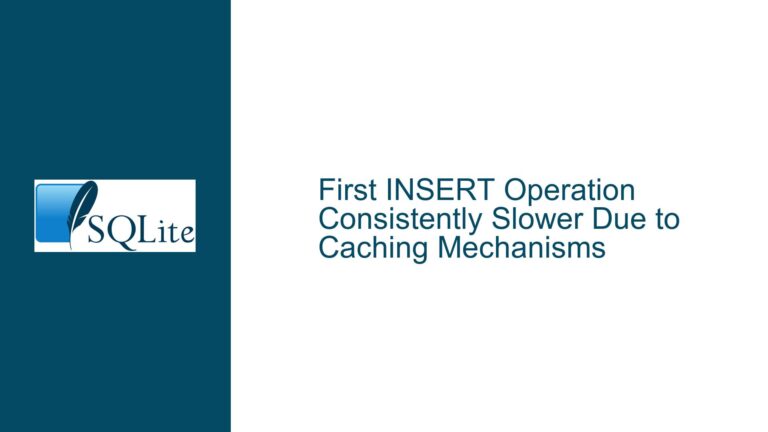Optimizing SQLite In-Memory Database Memory Usage and Avoiding Constant Reshaping
Understanding Memory Usage and Reshaping in SQLite In-Memory Databases
When working with SQLite in-memory databases, one of the most critical aspects to monitor and optimize is memory usage. In-memory databases are designed to store data entirely in RAM, which makes them exceptionally fast for read and write operations. However, this speed comes with the trade-off of having to manage memory efficiently, especially when the database is under heavy load or when the data size fluctuates significantly. The core issue here revolves around the constant reshaping of the database, as indicated by the fluctuating values of SQLITE_STATUS_MEMORY_USED and the highest memory usage reported by sqlite3_status.
The sqlite3_status function provides insights into the current and highest memory usage of the SQLite library. In the provided scenario, the memory usage is continuously increasing, and the highest memory usage is also rising, which suggests that the database is frequently resizing its memory allocation. This behavior can lead to performance degradation over time, as the database engine spends more time managing memory than processing queries. The question at hand is whether this constant reshaping can be avoided and if the SQLITE_FCNTL_CHUNK_SIZE control can be used to mitigate this issue.
Exploring the Role of SQLITE_FCNTL_CHUNK_SIZE in Memory Management
The SQLITE_FCNTL_CHUNK_SIZE is a file control operation that can be used to suggest a preferred chunk size for memory allocations. In the context of SQLite, a chunk size refers to the amount of memory that SQLite allocates at once for its internal data structures. By setting a preferred chunk size, you can potentially reduce the frequency of memory allocations and deallocations, which in turn can help stabilize memory usage and reduce the overhead associated with constant reshaping.
However, it’s important to note that SQLITE_FCNTL_CHUNK_SIZE is not a direct solution to the problem of constant reshaping. It is more of a tuning parameter that can help optimize memory allocation patterns. The primary cause of constant reshaping in an in-memory database is the dynamic nature of the data being stored. As new data is inserted, updated, or deleted, SQLite may need to resize its internal data structures to accommodate these changes. This resizing can lead to fluctuations in memory usage, as seen in the provided scenario.
Strategies to Stabilize Memory Usage in SQLite In-Memory Databases
To address the issue of constant reshaping and stabilize memory usage in an SQLite in-memory database, several strategies can be employed. These strategies range from tuning SQLite’s memory allocation behavior to optimizing the database schema and query patterns.
1. Preallocating Memory: One approach to reducing the frequency of memory allocations is to preallocate a larger chunk of memory at the start of the database session. This can be done using the SQLITE_FCNTL_CHUNK_SIZE control. By setting a larger chunk size, SQLite will allocate memory in larger blocks, which can reduce the number of allocations and deallocations required as the database grows and shrinks. However, this approach requires careful tuning, as setting the chunk size too large can lead to excessive memory usage, while setting it too small may not provide the desired stability.
2. Optimizing Database Schema and Queries: Another strategy is to optimize the database schema and query patterns to reduce the frequency of data changes that trigger memory resizing. For example, if the database is frequently inserting and deleting large amounts of data, it may be beneficial to batch these operations or use more efficient data structures. Additionally, ensuring that the database schema is normalized and that indexes are properly maintained can help reduce the overhead associated with data modifications.
3. Monitoring and Adjusting Memory Usage: Regularly monitoring memory usage using sqlite3_status can provide valuable insights into how the database is managing memory. By analyzing the trends in memory usage, you can identify patterns that may indicate inefficiencies or areas for optimization. For example, if the highest memory usage is consistently increasing, it may be a sign that the database is not releasing memory properly, or that the data size is growing beyond the available memory.
4. Using SQLite’s Memory Management Features: SQLite provides several features that can help manage memory usage more effectively. For example, the sqlite3_db_config function can be used to configure various aspects of the database connection, including memory management. Additionally, SQLite’s PRAGMA statements can be used to control various aspects of the database engine, such as the cache size and the page size, which can impact memory usage.
5. Considering Alternative Storage Engines: If the in-memory database is not meeting your performance or memory usage requirements, it may be worth considering alternative storage engines or database systems. For example, some databases offer hybrid storage engines that combine in-memory and on-disk storage, which can provide a balance between performance and memory usage. Additionally, some databases offer more advanced memory management features that may be better suited to your specific use case.
Implementing SQLITE_FCNTL_CHUNK_SIZE for Memory Optimization
To implement the SQLITE_FCNTL_CHUNK_SIZE control in your SQLite in-memory database, you can use the sqlite3_file_control function. This function allows you to send various control operations to the database file, including setting the chunk size. Here is an example of how to use sqlite3_file_control to set the chunk size:
#include <sqlite3.h>
#include <stdio.h>
int main() {
sqlite3 *db;
int rc;
int chunk_size = 1024 * 1024; // 1 MB
// Open an in-memory database
rc = sqlite3_open(":memory:", &db);
if (rc != SQLITE_OK) {
fprintf(stderr, "Cannot open database: %s\n", sqlite3_errmsg(db));
return 1;
}
// Set the chunk size using SQLITE_FCNTL_CHUNK_SIZE
rc = sqlite3_file_control(db, "main", SQLITE_FCNTL_CHUNK_SIZE, &chunk_size);
if (rc != SQLITE_OK) {
fprintf(stderr, "Failed to set chunk size: %s\n", sqlite3_errmsg(db));
return 1;
}
// Use the database...
// ...
// Close the database
sqlite3_close(db);
return 0;
}
In this example, the sqlite3_file_control function is used to set the chunk size to 1 MB. This means that SQLite will allocate memory in 1 MB chunks, which can help reduce the frequency of memory allocations and deallocations. However, as mentioned earlier, this approach requires careful tuning to ensure that the chunk size is appropriate for your specific use case.
Analyzing the Impact of Memory Reshaping on Performance
The constant reshaping of the database can have a significant impact on performance, especially in high-throughput environments where the database is under heavy load. Each time the database resizes its memory allocation, it incurs overhead in terms of CPU cycles and memory management. This overhead can lead to increased latency and reduced throughput, as the database engine spends more time managing memory than processing queries.
To quantify the impact of memory reshaping on performance, you can use profiling tools to measure the time spent on memory allocation and deallocation operations. For example, you can use the sqlite3_profile function to log the execution time of each SQL statement, including the time spent on memory management. By analyzing these logs, you can identify patterns that may indicate inefficiencies in memory usage and take steps to optimize the database accordingly.
Best Practices for Managing Memory in SQLite In-Memory Databases
Managing memory in SQLite in-memory databases requires a combination of tuning, monitoring, and optimization. Here are some best practices to help you get the most out of your in-memory database:
1. Regularly Monitor Memory Usage: Use the sqlite3_status function to monitor memory usage and identify trends that may indicate inefficiencies. By regularly monitoring memory usage, you can catch potential issues early and take corrective action before they impact performance.
2. Tune Memory Allocation Parameters: Experiment with different values for SQLITE_FCNTL_CHUNK_SIZE and other memory allocation parameters to find the optimal settings for your specific use case. Keep in mind that the optimal settings may vary depending on the size and complexity of your database, as well as the workload it is handling.
3. Optimize Database Schema and Queries: Ensure that your database schema is normalized and that indexes are properly maintained. Additionally, optimize your queries to minimize the number of data modifications that trigger memory resizing.
4. Use SQLite’s Built-in Features: Take advantage of SQLite’s built-in features for memory management, such as sqlite3_db_config and PRAGMA statements. These features can help you fine-tune the database engine to better manage memory usage.
5. Consider Alternative Storage Engines: If the in-memory database is not meeting your performance or memory usage requirements, consider alternative storage engines or database systems that may be better suited to your specific use case.
Conclusion
Optimizing memory usage in SQLite in-memory databases is a complex task that requires a deep understanding of how SQLite manages memory and how your specific use case impacts memory usage. By carefully tuning memory allocation parameters, optimizing your database schema and queries, and regularly monitoring memory usage, you can reduce the frequency of memory reshaping and improve the overall performance of your in-memory database. Additionally, considering alternative storage engines or database systems may provide a better solution if the in-memory database is not meeting your requirements. With the right approach, you can achieve a stable and efficient in-memory database that meets the demands of your application.






